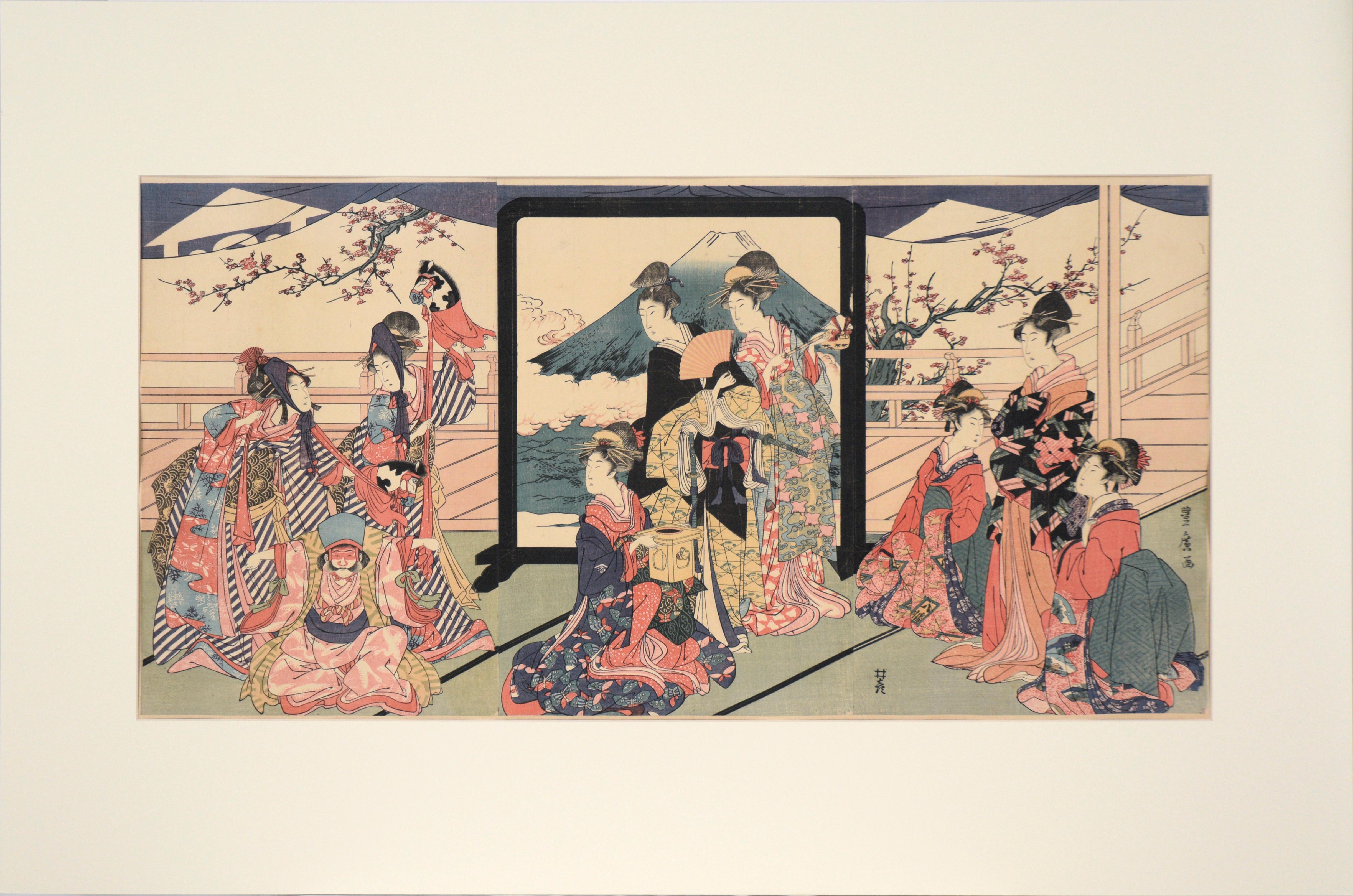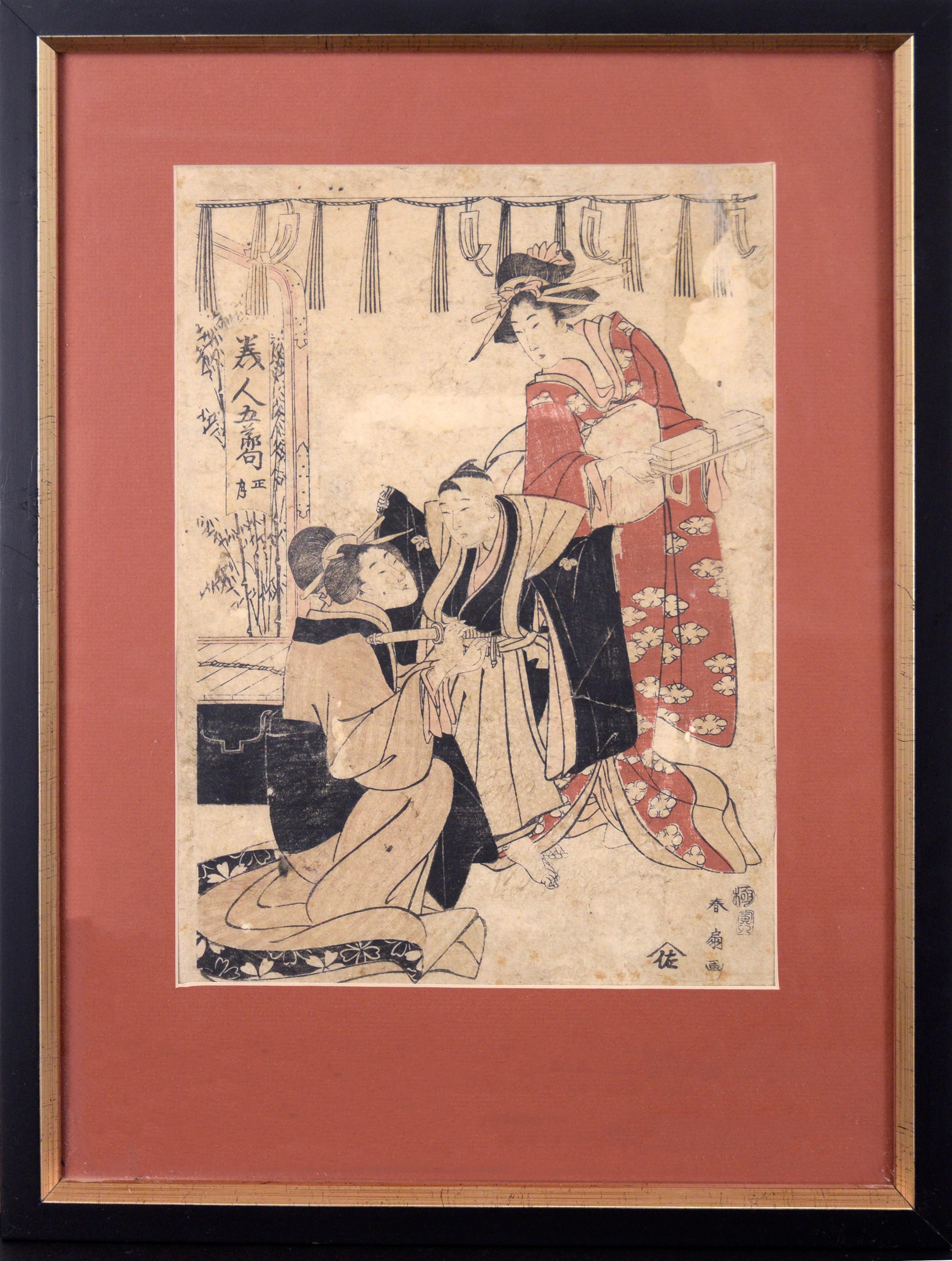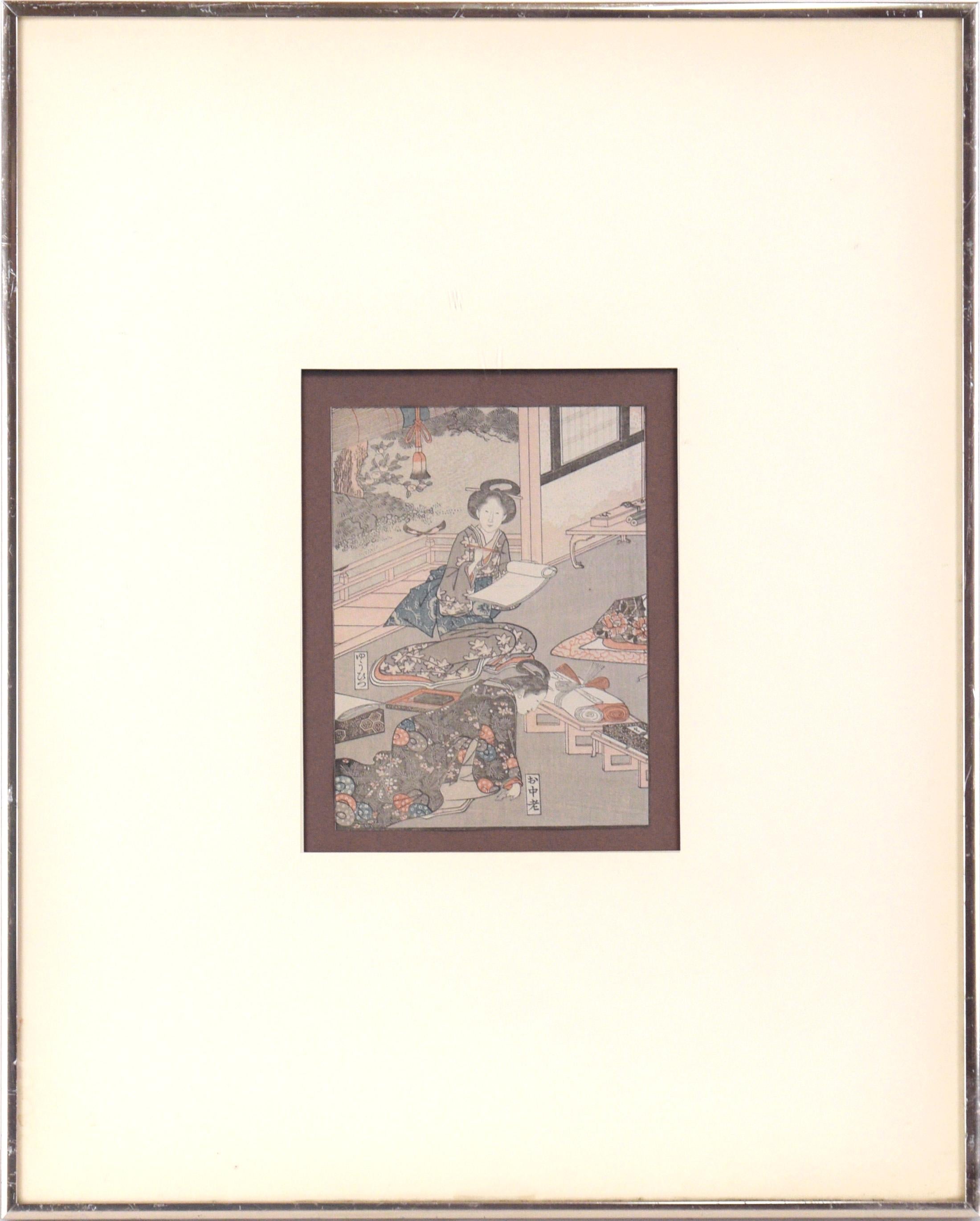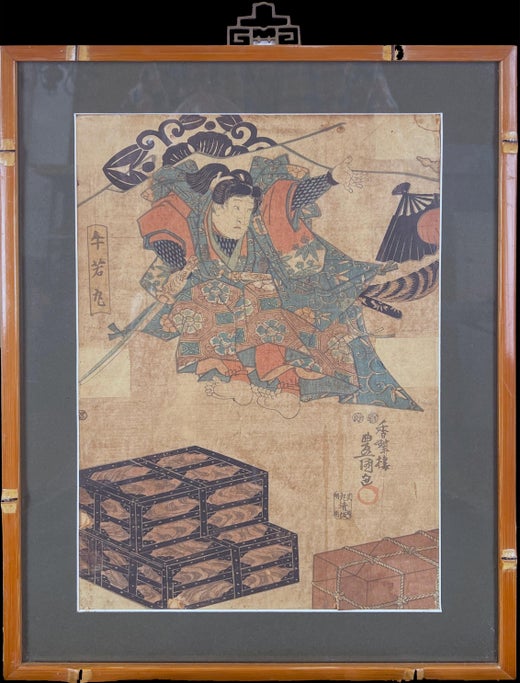Items Similar to Dressing Room 53 Stations of Tokaido - Woodblock Utagawa Hiroshige and Kunisada
Want more images or videos?
Request additional images or videos from the seller
1 of 13
Utagawa Kunisada (Toyokuni III)Dressing Room 53 Stations of Tokaido - Woodblock Utagawa Hiroshige and Kunisada1854
1854
About the Item
Dressing Room 53 Stations of Tokaido - Woodblock Utagawa Hiroshige and Kunisada
Elegant woodblock print by Utagawa Hiroshige I (Japanese, 1797–1858) and Utagawa Kunisada I (Toyokuni III) (Japanese, 1786–1864). In this series, the landscapes are by Hiroshige and the figures are by Kunisada I (Toyokuni III). Published by Maruya Kyûshirô. A lady of the court is getting her hair brushed by another woman while reading from a book. In the background, there is an expansive seascape with several boats of various sizes.
Signatures along the left edge.
Presented in a gold colored frame with a blue mat.
Frame size: 18.75"H x 15"Wx.75"D
Image size: 13.13"H x 9.63"W
Utagawa Hiroshige was born in 1797 in the Yayosu Quay section of the Yaesu area in Edo (modern Tokyo).[3] He was of a samurai background, and was the great-grandson of Tanaka Tokuemon, who held a position of power under the Tsugaru clan in the northern province of Mutsu.
Not long after his parents' deaths, perhaps at around fourteen, Hiroshige—then named Tokutarō— began painting. He sought the tutelage of Toyokuni of the Utagawa school, but Toyokuni had too many pupils to make room for him. A librarian introduced him instead to Toyohiro of the same school. By 1812 Hiroshige was permitted to sign his works, which he did under the art name Hiroshige. He also studied the techniques of the well-established Kanō school, the nanga whose tradition began with the Chinese Southern School, and the realistic Shijō school, and likely the linear perspective techniques of Western art and uki-e.
Hiroshige's apprentice work included book illustrations and single-sheet ukiyo-e prints of female beauties and kabuki actors in the Utagawa style. It was not until 1829–1830 that Hiroshige began to produce the landscapes he has come to be known for, such as the Eight Views of Ōmi series. He also created an increasing number of bird and flower prints about this time. About 1831, his Ten Famous Places in the Eastern Capital appeared, and seem to bear the influence of Hokusai, whose popular landscape series Thirty-six Views of Mount Fuji had recently seen publication.
An invitation to join an official procession to Kyoto in 1832 gave Hiroshige the opportunity to travel along the Tōkaidō route that linked the two capitals. He sketched the scenery along the way, and when he returned to Edo he produced the series The Fifty-three Stations of the Tōkaidō, which contains some of his best-known prints. Hiroshige built on the series' success by following it with others, such as the Illustrated Places of Naniwa (1834), Famous Places of Kyoto (1835), another Eight Views of Ōmi (1834).
During his lifetime Kunisada Utagawa was considered to be the best print designer by his contemporaries. He was more popular than Hiroshige, Hokusai or Kuniyoshi. And Kunisada was extremely productive. His total output is estimated at more than 20,000 designs, many made by his students.
Kunisada was born near Edo (today Tokyo) as the son of an affluent merchant with a ferry boat license. At the age of fifteen he joined the famous art school of Utagawa Toyokuni and took the name Kunisada.
In 1807 the young artist produced his first illustrated book. And in 1808 his first actor prints were published. His fame grew fast. While other artists like Kuniyoshi Utagawa or Hiroshige had to fight for recognition for years, he was successful from the beginning.
He went on to become the most commercially successful of all woodblock printmakers ever. His early success may not have had a good influence on his personality. He had a reputation for his conceited personality.
Kunisada designed a wide spectrum of traditional ukiyo-e subjects like kabuki themes, beautiful women, historical events and quite a few shunga prints. He made few landscapes.
--
- Creator:Utagawa Kunisada (Toyokuni III) (1786-1864, Japanese)
- Creation Year:1854
- Dimensions:Height: 18.75 in (47.63 cm)Width: 15 in (38.1 cm)Depth: 0.75 in (1.91 cm)
- Medium:
- Movement & Style:
- Period:
- Condition:Tonal ageing to paper. Wrinkles and tears in upper portion of paper - stabilized as long as the item is not removed from mat and frame.
- Gallery Location:Soquel, CA
- Reference Number:
Utagawa Kunisada (Toyokuni III)
Born in the Honjo district of Edo as Kunisada Tsunoda, Kunisada’s family owned a small hereditary ferryboat service. Though his father, an amateur poet, died when Kunisada was a child, the family business provided some financial security. During his childhood, he showed considerable promise in painting and drawing. Due to strong familial ties with literary and theatrical circles, he spent time studying actor portraits. At age 14, he was admitted to study under Toyokuni, head of the Utagawa school. Kunisada's work embodies the characteristics of the Utagawa school, focusing on traditional subjects such as kabuki, bijin (beautiful women), shunga (erotic prints), and historical prints. His first known print dates to 1807, his first illustrated book to 1808. Kunisada’s career took off from the beginning. Many of his works became overnight successes and he was considered the “star attraction†of the Utagawa school. He signed his works “Kunisada,†sometimes with the studio names of Gototei and Kochoro affixed. In 1844, he adopted the name of his teacher and became Toyokuni III. Kunisada passed away in 1864 in the same neighborhood that he was born. He was 70 years old. Kunis
About the Seller
4.9
Platinum Seller
These expertly vetted sellers are 1stDibs' most experienced sellers and are rated highest by our customers.
Established in 1986
1stDibs seller since 2014
2,523 sales on 1stDibs
Typical response time: <1 hour
- ShippingRetrieving quote...Ships From: Soquel, CA
- Return PolicyA return for this item may be initiated within 14 days of delivery.
More From This SellerView All
- "Toy Horse Dance" Japanese Woodblock Triptych with Beauties and Mt FujiLocated in Soquel, CA"Toy Horse Dance" Japanese Woodblock Triptych with Beauties and Mt Fuji Vibrant three-panel woodblock print by Utagawa Toyohiro (Japanese, 1773–1828). Court ladies look on as a grou...Category
Early 20th Century Edo Figurative Prints
MaterialsWoodcut, Rice Paper, Ink
- Beauties Mirrored in the Forms of Flowers - Utagawa Kuniyoshi Japanese WoodblockBy Utagawa KuniyoshiLocated in Soquel, CABeauties Mirrored in the Forms of Flowers - Utagawa Kuniyoshi Japanese Woodblock A Japanese beauty dressed and posed resembling flowers by Utagawa Kumiyoshi (Japan, 1797 - 1861 ). A...Category
Mid-19th Century Edo Figurative Prints
MaterialsPaper, Ink, Woodcut
- Dressing the Boy Samurai - Kuniyoshi Japanese Woodblock Print Original Wood CutBy Utagawa KuniyoshiLocated in Soquel, CADressing the Boy Samurai - Kuniyoshi Japanese Woodblock Print Original Wood Cut A young Samurai boy is finishing dressing with the help of a younger sister while his mother looks on ...Category
1850s Edo Figurative Prints
MaterialsPaper, Ink, Woodcut
- Scribe and Personal Assistant to the Shogun - Japanese Woodblock Print on PaperLocated in Soquel, CAScribe and Personal Assistant to the Shogun - Japanese Woodblock Print on Paper Detailed woodblock print by an unknown artist, In the style of Suzuki Harunobu. There are two women i...Category
19th Century Edo Figurative Prints
MaterialsPaper, Ink, Woodcut
- The Four Seasons: Spring Japanese Woodblock Triptych ink on Paper Tales of GenjiLocated in Soquel, CAThe Four Seasons: Spring - Japanese Woodblock Triptych in Ink on Paper Colorful kabuki scene by Utagawa Kuniteru (Japanese, active 1818-18...Category
Early 19th Century Edo Figurative Prints
MaterialsPaper, Ink, Woodcut
- Elegant Amusements of Eastern Genji - Japanese Triptych Woodblock Print on PaperBy Utagawa Kunisada (Toyokuni III)Located in Soquel, CAElegant Amusements of Eastern Genji - Japanese Triptych Woodblock Print on Paper Dynamic woodblock print with several elegantly dressed figures by Utag...Category
1850s Edo Figurative Prints
MaterialsPaper, Ink, Woodcut
You May Also Like
- The Lonely House at Asajigahara.Located in Middletown, NYA scene from a series of ghost stories and spooky rural legends. Tokyo: Matsuki Heikichi, 1896. Woodcut in ink with embossing and hand-coloring in watercolor on handmade mulberry pa...Category
Late 19th Century Edo Figurative Prints
MaterialsWatercolor, Woodcut, Handmade Paper
- Dyeing PaperLocated in Middletown, NYJapan: circa 1770. Woodcut on cream laid paper, 7 1/4 x 2 1/2 inches (182 x 63 mm), narrow margins. Laid down to non-archival board with scattered soiling and some adhesive staining...Category
Late 18th Century Edo Figurative Prints
MaterialsHandmade Paper, Woodcut, Laid Paper
- Two Women Playing Sugoroku from "Comparison of the Customs of Beauties."Located in Middletown, NYA scene from a vanishing Japan. Two Women Playing Sugoroku from "Comparison of the Customs of Beauties."; The Customs and Manners of Women Japan: Matsuki Heikichi, 1891. Woodblock ...Category
Late 19th Century Edo Figurative Prints
MaterialsHandmade Paper, Watercolor, Woodcut
- Woodcut Print Mimi Grooms Signed Small Edition Happy Birthday Woodblock PrintBy Mimi GrossLocated in Surfside, FLMimi Gross Grooms (American, born 1940) first print, black and white woodcut or woodblock print on paper "to... Happy Happy Birthday Lots of love and...Category
20th Century Contemporary Figurative Prints
MaterialsTissue Paper, Woodcut
- Once upon a time in London, Morning, Woodcut print, Vincent Van Gogh, SunflowersBy Mychael BarrattLocated in Deddington, GBA limited edition woodcut on paper print by Mychael Barratt of Vincent Van Gogh in his bedroom with his dog. Sunflowers appear in the background, brightening up a blue and purple room. Additional information: Mychael Barratt Once upon a time in London, Morning Woodcut on paper Signed and titled in pencil Numbered from the edition of 100 Image size Height: 27.5 cm Width: 27 cm Complete size of sheet Height: 39.6 cm Width: 37.5 cm Depth: 0.2 cm ARTIST PROFILE: Mychael Barratt was born in Toronto, Canada, however, considers himself to be a Londoner since arriving for what was supposed to be a two-week stay thirty years ago. He is a narrative artist whose work is steeped in imagery relating to art history, literature, theatre and everything else that overfills his bookshelves. He was an artist in residence for Shakespeare’s Globe Theatre...Category
2010s Contemporary Figurative Prints
MaterialsPaper, Woodcut
- Dickie (Child in High Chair)By Will BarnetLocated in Buffalo, NYAn original woodcut on japan paper created by master American artist Will Barnet in 1942.Category
1940s American Modern Figurative Prints
MaterialsWoodcut, Paper
Recently Viewed
View AllMore Ways To Browse
Toyokuni Woodblock
Japanese Woodcut Kabuki
Paintings Of Japanese Boats
Toyokuni 3
Lithograph 1973
18th Century Neoclassic Engravings
Pablo Picasso Signed And Numbered
In The Style Of Pablo Picasso
Vintage New Years Poster
Vintage New Years Posters
Vintage Poster Drawing
1810 Art
Good Conversation
Vintage Move Posters
Parisian Print
Parisian Prints
Vintage Philadelphia Prints
Vintage New York City Poster






